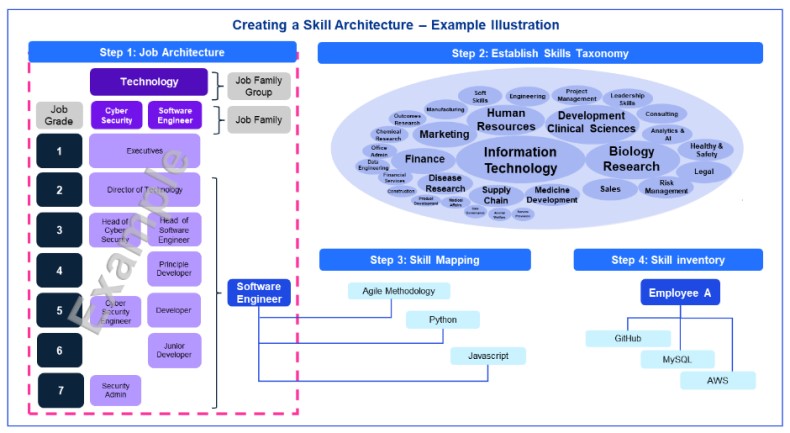Do you need to pay for skills?
With the rapid advance of artificial intelligence (AI) and the increasing automation of routine tasks and processes, the type of skills required by organisations is rapidly changing.
With increasing demand for certain skills such as AI and data analytics, we see very significant corresponding pay premiums.
Does this mean that employers need to start paying for skills going forward?
Pre-requisites for skills-based pay
Skills architecture
To implement a skills-based pay system, establishing an effective job architecture and skills architecture is an indispensable first step.
A skills architecture maps skills to roles (demand) in the job architecture and to employees (supply).

This enables organisations to identify critical skills combined with an understanding of market pay where a skills premiums might be paid.
A skills architecture is not only critical for pay, but also in workforce planning, learning and development, and in developing a talent market place (see more on skills architecture).
Skills-based pay data
To pay for skills you need data on pay levels by skills.
There is a lot of job-based data but not so much on jobs plus skills. Where data is available it is typically around tech and data science type roles.
However, as this is an area where we see many of the premiums it may still be very useful.
Options for managing skills-based pay
Certain future-of-work practitioners suggest that in the future there may be no actual jobs and work will be achieved by bringing together the appropriate skillsets.
If this ever happens it’s a long way off.
Even agile project teams are currently made up of different job types.
What we see now are jobs (which may or may not already attract a pay premium) + skills which attract a market premium above the average for that job.
A number of different approaches are used:
1. Skills premium as exceptions
The most typical new approach seen in the market is to grant skill premium as an exception on a case-by case basis.
A fifth (20%) of respondents to a KPMG survey said they manage skills premiums as exceptions.
This approach can help to attract and retain talent with ‘hot’ skills in the market.
However, if not managed carefully, it may lead to large number of inconsistent exceptions, incorrect use of grading – and create an equal pay risk.
This approach also means permanent salary increases that can’t be removed if the skills become less scarce in the future.
2. Premium plus pay band
To accommodate higher-than-usual market pay levels for specific roles or skills, such as those in the digital or tech fields, some organisations establish a "Premium plus" pay band in addition to their traditional pay structure.
In the KPMG survey, 14% of respondents said they pay for skills via premium (plus) bands. This approach offers relatively easier management and a more robust governance framework for pay administration.
But like the exceptions approach, this one leads to permanent salary increases.
3. Skills allowance
A skills allowance is paid on top of base salary to reward employees with critical or in-demand skills.
One in ten (10%) of respondents in the survey said they pay for skills through allowances.
These can be reviewed over time and potentially removed if skills become less premium.
Some organisations flag changes to skills over time to encourage skills development. Employees that continue to develop can continue to keep their premium.
This approach provides a relatively robust framework to minimise equal pay risks and has minimal impact on the underlying salary structure.
It does, however, introduce additional administrative burden and may create potential retention challenges if allowances are removed.
Do you really need skills-based pay?
With the growth of AI, quantum computing and other technological advances, we continue to see the demand for digital talent growing.
We see very significant premium in pay for certain skills, which companies will have to deal with one way or another.
We are therefore likely to see the use of job+skills pay in technology and data science functions on a formal basis.
However, given the lack of data and less pay pressure on specific skills outside of technology and data science, we may see a more ad hoc approach in other functions.
Employers should consider how they might respond to these developments to retain their edge in the competition for talent.
Specific points to consider include:
- Do we need to update our job architecture or adopt a new skills architecture?
- Do our current pay structures meet our current and future talent needs?
Our KPMG Reward Consulting team is here to partner with you in developing an effective Skill Architecture and optimising your pay structure to attract and retain talent. Please contact Scott Cullen and Susie Zhu to discuss your specific needs.
Supplied by REBA Associate Member, KPMG LLP
KPMG total reward and benefits solutions cover: Assessment, Design ,Compliance, Legal and Technology








